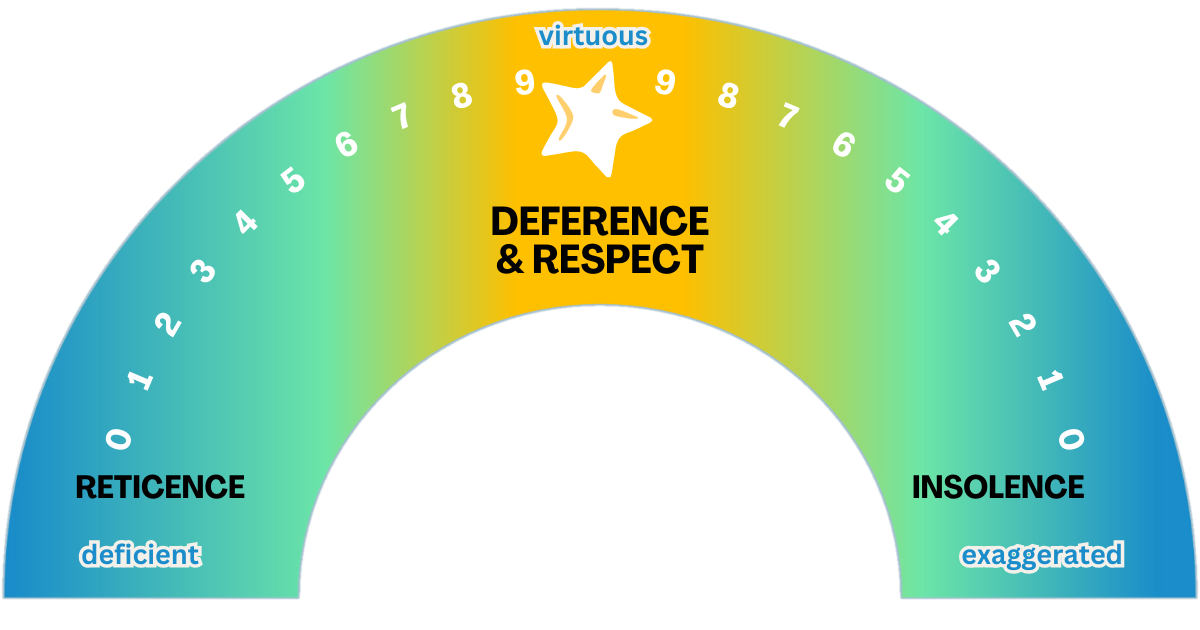We live in a world with others, and our interactions with them are inevitable and often complex. Each of us has unique mindsets and habits when it comes to responding to others. In this section, we’ll delve into the character traits and attitudes that shape how we respond to others.
The Continuum
Along the continuum of responding, individuals can fall at various points. On one extreme is reticence, characterized by a reluctance or hesitancy to respond or engage with others, often out of deference or shyness. On the other extreme is insolence, marked by disrespect or defiance in one’s responses, often reflecting a lack of regard for others’ feelings or perspectives. The virtuous path lies in the center, where individuals respond with deference and respect, acknowledging others’ viewpoints while maintaining their own boundaries and assertiveness.
People may find themselves at various positions on this continuum. To make things even more complex, some may shift their position based on the circumstance. For instance, while some individuals may hesitate to respond in certain situations, they might exhibit assertiveness in others.
Reticence/Hesitance: At this extreme, individuals exhibit a strong hesitancy to speak up, often remaining silent even when prompted to contribute to a conversation or discussion.
Reluctantly Responding: Progressing, individuals respond only when absolutely necessary, secretly wishing they were not asked. Their answers are brief and curt, providing only the essential information without any additional elaboration.
Respectful Deference: As the median, individuals engage in thoughtful consideration before responding. They carefully weigh their words, considering how best to convey their thoughts while showing empathy and understanding toward others’ perspectives.
Assertiveness: Advancing along the spectrum, individuals speak confidently and assertively, sometimes without much regard for how their words may be received. They prioritize the expression of their own viewpoints, projecting a sense of self-assurance in their communication.
Insolence: At the extreme end of the continuum, individuals display arrogance and rudeness in their interactions, showing a blatant disregard for the feelings or perspectives of others. They express themselves without concern for the impact of their words, focusing solely on their own interests or desires.
Benefits of Deference & Respect
When we cultivate a balanced approach to responding, embodying deference and respect while finding the equilibrium between reticence and insolence, we foster harmonious interactions and mutual understanding. This balance allows us to navigate social situations with grace and empathy, fostering positive relationships and effective communication.
Here are some benefits:
Deeper connections. Treating others with respect and kindness helps us forge stronger relationships. When we’re friendly and considerate, people tend to respond better, making conversations feel more genuine and building trust between us.
Positive environment. Bringing an attitude of respect and openness into our everyday interactions sets the stage for good teamwork and creativity to flow. It creates an atmosphere where everyone feels valued and heard, leading to a more positive and productive environment.
Enhanced emotional well-being. Approaching others with kindness and understanding not only makes them feel better but also boosts our own mood. When we show empathy and consideration, it fosters a sense of connection and well-being for everyone involved.
Positive example. Leading by example is powerful. When we show respect and consideration in our words and actions, it sets a positive tone for others to follow. It creates a ripple effect of kindness and understanding, making our communities more compassionate and supportive places to be.



